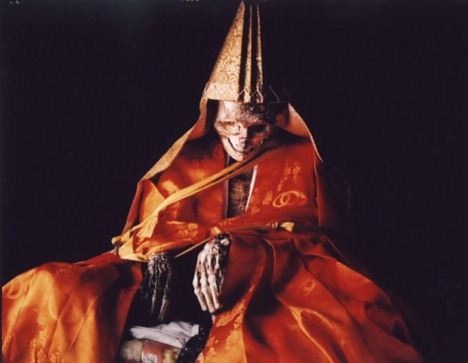
|
|||
Sokushinbutsu - The Bizarre Practice of Self Mummification
Source : http://en.wikipedia.org/wiki/Sokushinbutsu
Scattered throughout Northern Japan around the Yamagata Prefecture are two dozen mummified Japanese monks known as Sokushinbutsu, who caused their own deaths in a way that resulted in their mummification. The practice was first pioneered by a priest named Kuukai over 1000 years ago at the temple complex of Mount Koya, in Wakayama prefecture. Estimates of the number of self-mummified priests in Japan range between sixteen and twenty-four priests. Impressive though this number is, many more have tried to self-mummify themselves; In fact, the practice of self-mummification -- which is a form of suicide, after all -- had to be outlawed towards the end of the 19th century to prevent Buddhist priests from offing themselves this way. and yet the grand majority of priests who have tried to do this have failed. The reasons will take some explaining -- but first, some background on the whole practice and the reasons for it. Sokushinbutsu refers to a practice of Buddhist monks observing austerity to the point of death and mummification. This process of self-mummification was mainly practised in Yamagata in Northern Japan between the 11th and 19th century, by members of the Japanese Vajrayana school of Buddhism called Shingon ("True Word"). The practitioners of sokushinbutsu did not view this practice as an act of suicide, but rather as a form of further enlightenment. Those who succeeded were revered, while those who failed were nevertheless respected for the effort. It is believed that many hundreds of monks tried, but only 24 such mummifications have been discovered to date. There is a common suggestion that Shingon school founder Kukai brought this practice from Tang China as part of secret tantric practices he learned, and that were later lost in China. Today, the practice is not advocated or practiced by any Buddhist sect, and is banned in Japan. The practice was satirized in the story "The Destiny That Spanned Two Lifetimes" by Ueda Akinari, in which such a monk was found centuries later and resuscitated. So truely devote Buddhist priests are not afraid of death; but they don't normally seek it either, as this too would be an abnormal obsession with the physical world. The priests that chose to practice self-mummification were usually all older men, who knew they had limited time left to their lives anyway... and since the practice takes years to lead to a sucessful death and mummification, it cannot be characterized as an attempt to reach enlightenment quickly as a normal suicide might be. Rather, the intended purpose of this practice for these priests is to both push their ability to disregard their physical selves to the limit of their ability, and to try and leave an artifact of this struggle that will stand as a symbol of their beliefs to those that are priests after them. The practice of self-mummification seems somewhat macabre to today’s civilized population. However, for some sects of Buddhist priests, it was a form of further enlightenment. Many of these priests voluntarily went through a ten-year gruesome process of self-mummifying, belie ving that extreme physical pain and denial created an opening to a higher spiritual level, the ultimate attainment of “passing into the state of nirvana.” The practice of self-mummification in Japan has its roots in the esoteric school of Shingon Buddhism called the Shingon-Shu, established in the Heian Period (794-1185). The founder of this new Buddhist movement was a monk named Kobo Daishi, also recognized as Kukai. Kukai’s teachings reflect an influence derived from Tantric Buddhism, which comes from the Great Vehicle Sect, called the Mahayana School. Between the years 804 and 806, Kukai studied in the rural province of T’ang in China, where he worked on mastering esoteric practices. After having studied in China, Kukai returned to Japan bringing with him the three theological building blocks that were the basis of the Shingon School. The first was the idea of the all-powerful syllable, the meaning of which can be found in the etiological root of the word “Shingon.” Shingon is taken from the Chinese word “Chin-yen” (true word). Chin-yen is a transliterated form of the Sanskrit word for “mantra” (sacred noise making up the universe, such as the syll able “om”). The next theological seed was the most important iconographical symbol in esoteric Buddhism, the two Mandal as denoting the impermanence of life and the inevitability of birth and rebirth in the ever-moving wheel of Samsara. The third and most influential to esoteric Buddhism’s dev elopment in the Japan came back with Kukai in the translated form of two Tantric Buddhist scriptures known as the Machav airocana sutra, describing the relationship between man and the cosmic Buddha, and the Sarvatathagatatattvasamgraha sutra. These texts were especially helpful in giving Shingon the claws to dig into and plant the seeds of esoteric Buddhism’s fertility in Japanese religious history. Kukai transliterated these texts into the vernacular from Sanskrit. His transliterations played a pivotal role in the formation of the Shingon School. Long after Buddhists in the native country of India discarded the two sutras and the Chinese no longer practiced their rituals, the Japanese kept the practices alive. These secret teachings spread to a variety of places.“Esoteric Buddhist history was practiced from India to Central Asia, Ceylon, China, Korea, Japan, Mongolia, Nepal, Indonesia, Southeast Asia, and Tibet.” By the seventh or eighth century, secret Buddhist rituals, like self-mummification, reached an apex and developed in regions of Japan. How to be a self-made mummy Scientific study of the mummies and the process that created them only began in the early 1960's. It was generally expected that the mummies studied would show signs of having been mummified after death by other priests, in much the way Egyptian mummies -- and almost all other mummies on Earth -- have been created. The first step in that process is the removal of the internal organs, because the bacteria in these begin the process of decomposition within hours of death; with these removed, it is relatively easy to prepare, dry, and preserve the remainder of the body. But x-rays discounted this expectation... the internal organs were intact, which meant that mummification had been accomplished in some new way that scientists had not yet encountered. So the process itself was next investigated. The actual practice was first pioneered by a priest named Kuukai over 1000 years ago at the temple complex of Mount Kooya, in Wakayama prefecture. Kuukai was founder of the Shingon sect of Buddhism, which is the sect that came up with the idea of enlightenment through physical punishment. There were three steps in the process of self-mummification that Kuukai proposed, and the full process took upwards of ten years to lead to a successful mummification. The first step is a change of diet. The priest was only allowed to eat nuts and seeds that could be found in the forests surrounding his temple; this diet had to be stuck to for a 1000 day period, a little under three years. During this time, the priest was to continue to subject himself to all sorts of physical hardship in his daily training. The results were that the body fat of the priest was reduced to nearly nothing, thus removing a section of the body that easily decomposes after death. 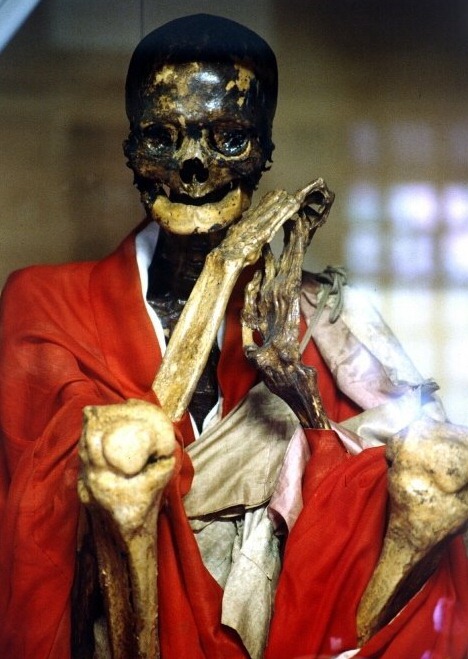
The third and last step of the process was to be entombed alive in a stone room just big enough for a man to sit lotus style in for a final 1000 day period. As long as the priest could ring a bell each day a tube remained in place to supply air; but when the bell finally stopped, the tube was removed and the tomb was sealed. When the tomb was finally opened, the results would be known. Some few would be fully mummified, and immediately be raised to the rank of Buddha; but most just rotted and, while respected for their incredible endurance, were not considered to be Buddhas. These were simply sealed back into their tombs. But why did some mummify and some not? This is the tricky part of the whole process. It is not clear if this is part of the process as set down by Kuukai, but in Yamagata is a sacred spring. This spring is on a mountain called Yudono, which is in fact the third sacred mountain of the three I visited in 1998. Many of the priests in the area considered both the water and the mineral deposits from this spring to have medicinal value, and may have injested one or both previous to their entombment. An analysis of the spring water and deposits revealed that they contain enough arsenic to kill a human being! Arsenic does not get eliminated from the body, so it remains after death... and it is toxic to bacteria and other micro-organisms, so it eliminated the bacteria that started the decompostion of the body. 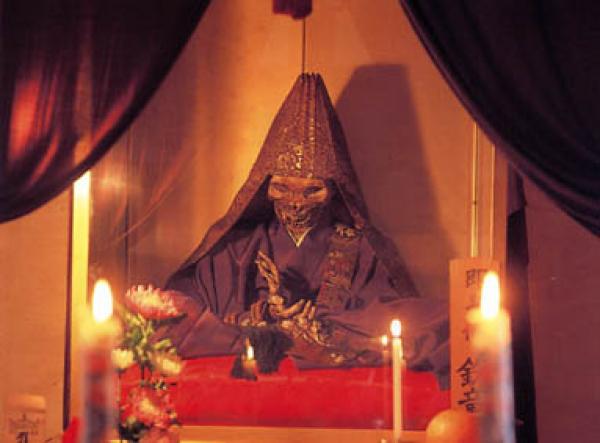 The Shingon priests’ beliefs in the path to salvation can be described by explaining the mindset behind the strange, ritualistic, practice of self-mummification. The psychological mindset of the to-be mummified person is important in allowing empathy with the priest. “Personal life and death does not matter, but being kind to your fellow beings and guiding them towardself-realization of their greater connection to the Buddha does. So, truly devout Buddhist priests are not afraid of death.” The importance of such psychoanalysis can be observed in Richard Payne’s discussion of Shingon’s four ritual stages of self-transformation of the mind called Shindo Kegyo. In his discussion, he us psychology as a tool for analyzing this four-pronged ritual transformation. “Clearly, ritual must be more than a mechanical technique (such as simple breathing exercises might be).” The practitioners of such rituals report elated feelings of connection to generations of previous worshipers. 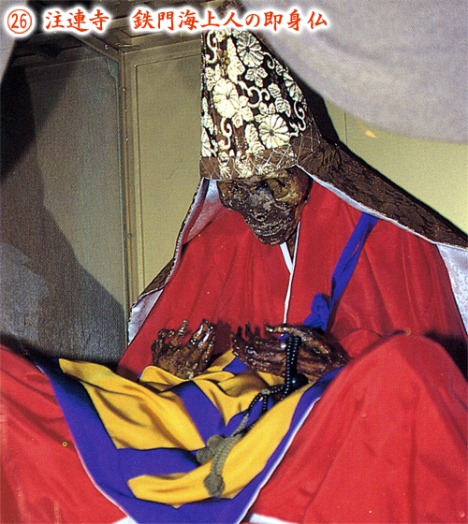 Another important aspect of Shindo-Keygo, and in particular self-mummification, is the belief in Tantric Buddhism that one has the “possibility of realizing enlightenment in this very lifetime.” Hence, self-mummification must have developed as a vehicle to fill the void created by the debacle of how to achieve earthly salvation, a principal very different from most Buddhist doctrine. The last phase of a Shingon priest’s ritualistic development is called Kendoku (attaining realization), which usually takes place in the latter years of the priest’s life when he becomes more likely to participate in self-mummification activities. The process of self-mummification is broken down into three 1,000-day periods. Each period is characterized by physical and mental changes caused by phase-specific austerities and excruciating pain. The process is not some mystic secret, but rather a calculated scient ific means for ridding the body of material that cannot cross over into nirvana. In the first phase the priest is restricted to a diet of only nuts and grains surrounding the temple complex.During this time the practitioner endures extreme hardships, such as meditating under icy cold mountain streams for hours on end. “Japan is a mountainous country.” Therefore, most of the Shingon temple complexes are in the proximity of large sacred mountains.During the second phase of the process, the fat matter that causes the body to decompose is greatly reduced. Upon entering the second one thousand-day period, the priest’s body fat is near zero. In this stage, the diet is restricted even fu rther to only miniscule amounts of pine bark and roots from pine trees. 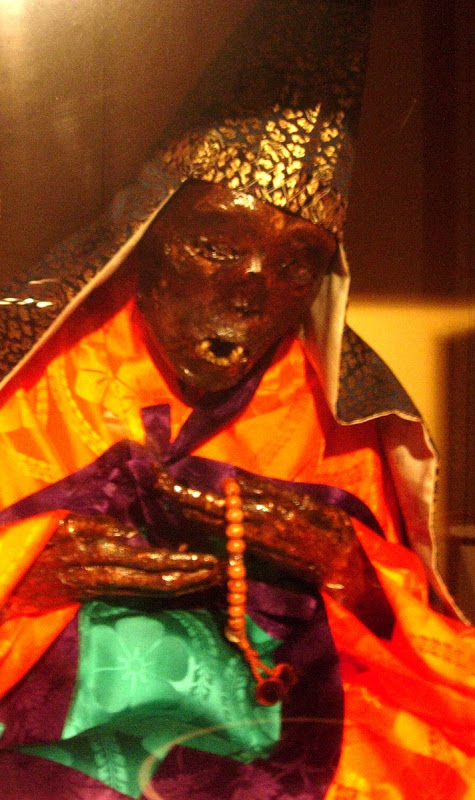 After this stage, the priest is like a “skin-covered skeleton.” The dehydration helps in preservation of the body. Towards the end of the second stage, “A special tea is made from the sap of the urushi tree.” This sap is used as a lacquer for furniture. The tea is a poisonous concoction that causes vomiting and sickness that further decrease the moisture in the body, but more importantly, its build up in the system prevents insects from speeding up the decomposition process. This, in turn, helps the self-mummification process by protecting the to-be mummified priest from natural elements. Upon entering the final stage, the priest is given a bell and then sealed in his tomb where a tube is inserted into a small opening in the top. Every day, he rings the bell. Eventually, when the ringing stops, the tube is removed. At the end of the last 1000-day period, nearly ten years a fter starting, the tomb is opened and the results are seen. Out of the thousands who have tried to complete this decade long process, most are decomposed, and thus, have failed in their efforts. Only a select few actually achieve this fascinating but grisly transformation. The priests who triumphed in their endeavor are said to be one with the cosmic Buddha. While the people who tried and failed are praised for their fervor, they are not thought to be Buddha. Therefore, they enter back into the wheel of Samsara. One of the questions scientists pose is why some bodies decompose while others mummify. “In a place called Yamagata, there is a sacred spring on a mountain called Yudono.” In this area, there have been reported higher levels of mummification success. It was in the same area that Kukai first pioneered this practice in Japan. Many of the priests from this prefecture reported drinking water before entombment. Submit News/Videos/Links | Discuss article | Article Link | More Unsolved and Unexplained Mysteries |
More can be addded on request. Direct your requests at vinit@theunexplainedmysteries.com
